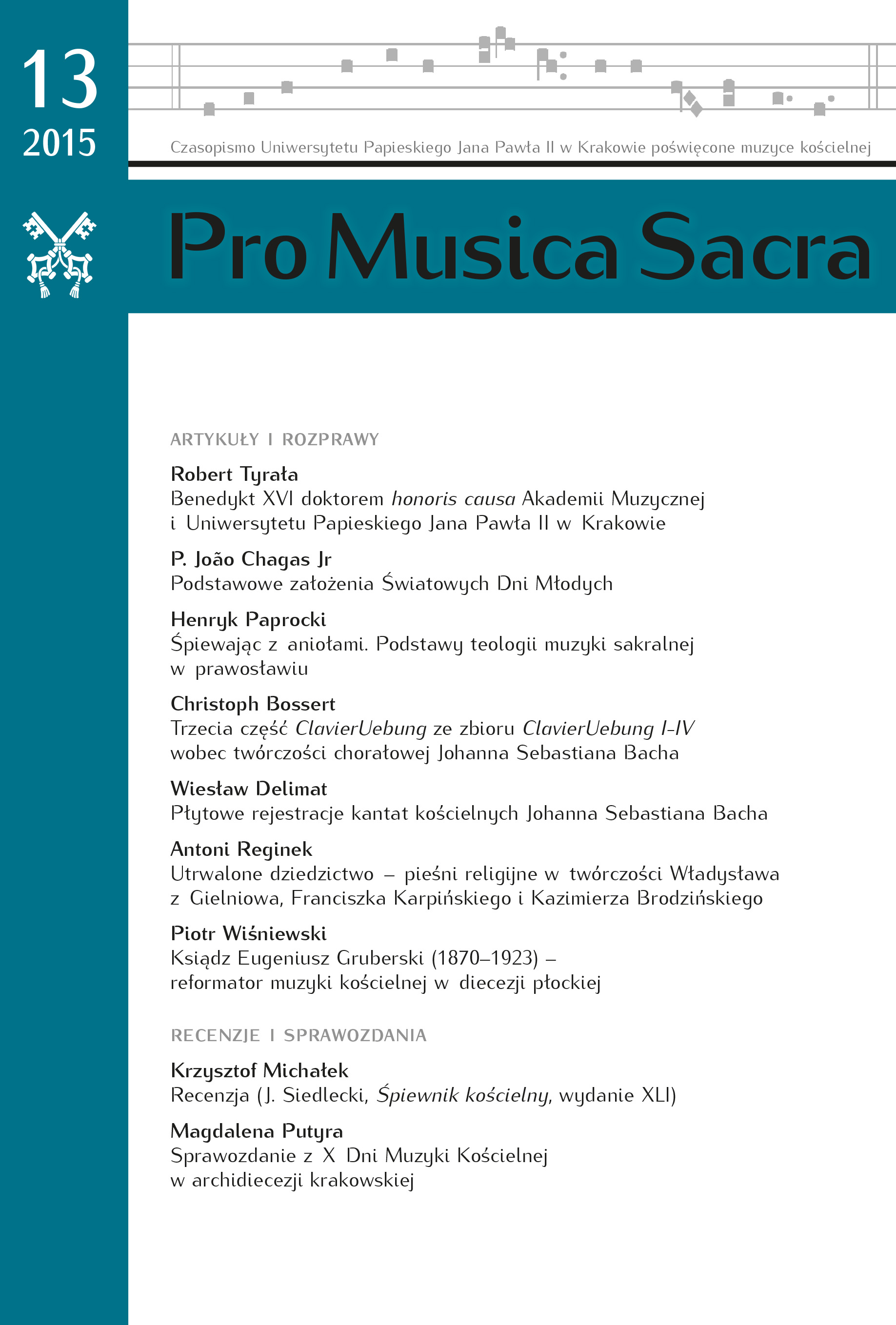Singing with the Angels. The Foundations of the Theology of Sacred Music in orthodoxy
DOI:
https://doi.org/10.15633/pms.1115Keywords:
sacred music, liturgy, Orthodoxy, estheticsAbstract
The author’s reflections on the theology of sacred music in Orthodoxy commences with the fact that the entire Liturgy is precisely outlined in the book known as the Typikon, which is at the same time a scenario and score of the service. The Typikon introduces order in the elements of prayer and also places an emphasis on beauty. For this reason, concepts such as artistry, artist, art and creativity play such an important role in the thought of the Church Fathers. The essence of this music is fundamentally an unceasing pursuit of the heavenly archetype, in order to attain unity between the divine realm and the human world. Liturgical music is therefore one of the ways of overcoming the fallen state and recovering the unity lost. The theory of church singing originates in Byzantium and influenced the formation of the Byzantine musical form, which delighted Prince Vladimir’s representatives in Constantinople. The beauty of the Greek Liturgy has become one of the criterions of authenticity of faith. The fascination with the beauty of the Liturgy is not an esthetic evaluation, but is a desire to grasp the essence of God through beauty. The Byzantine concept has been heavily influenced by the idea of the divine pattern, which was given to people by God by the angels or saints. This principle applies to all types of art including music. According to tradition, the well-known Byzantine hymnographer, poet and musician St. Roman the Melodist received the gift of arranging kontaktions and chants in a vision. The Mother of God appeared to him in a church and gave him a scroll with the instructions to consume it. After waking up, Roman the Melodist sang “Today the Virgin Gives Birth.” As a result, his creativity is the fruit of a gift received from God. Moreover, comparing church chants with the heavenly (from the 8th century, choir) is expressed in liturgical hymns, which tell of human voices blending with the songs of the Cherubim, thus creating a choir proclaiming the glory of God as “an icon in sound.” Liturgical chant contrasts itself with folklore songs. Church singers represented the angels, and for this reason, the name “choir” makes reference to the concept of the nine choirs of angels. Liturgical chant should sound solemnly, heavenly, and should be dematerialized (complemented by church architecture, giving the effect of poured out sounds rising to the dome of the church and returning as celestial and heavenly chant).
References
Arranz M., Istorija tipikona. Opyt, Leningrad 1978.
Egeria, Pielgrzymka do miejsc świętych, przekł. W. Szołdrski, Warszawa 1970.
Florenski P., Świątynia jako synteza sztuk, [w:] P. Florenski, Ikonostas i inne szkice, przekł. Z. Podgórzec, Białystok 1997, s. 33–47.
Florenski P., Liturgia jako synteza sztuk, [w:] P. Florenski, Ikonostas i inne szkice, przekł. Z. Podgórzec, Białystok 1997, s. 35–38.
Heger P., The Development of Incense Cult in Israel, Berlin–New York 1997.
Jeanin J., Puyade A., L’Octoechos syrien. Etude historique, „Oriens Christianus” 13 (1913), z. 3, s. 87–89.
Kovalevsky M., Chant liturgique, icône sonore, [w:] Nicée II. 787–1987. Douze siècles d’images religieuses, Paris 1987, s. 225–237.
Kovalevsky M., Le Rôle du choeur dans la liturgie chrétienne, [w:] L’Assemblée liturgiques et les differents rôles dans l’assemblée, Roma 1977, s. 225–307.
Lidow A., Sozdanije sakralnych prostranstw kak wid tworczestwa i priedmiet istoriczeskogo issledowanija, [w:] Ijerotopija. Issledowanije sakralnych prostranstw, Moskwa 2004, s. 17–21.
Paprocki H., Ikona jako twórcze przezwyciężenie zła, „Wiadomości Polskiego Autokefalicznego Kościoła Prawosławnego” 15 (1985), z. 1–4, s. 40–50.
Paprocki H., Liturgia i estetyka, „Wiadomości Polskiego Autokefalicznego Kościoła Prawosławnego” 20 (1990), z. 77, s. 22–30.
Paprocki H., Teologia muzyki sakralnej, [w:] Chrześcijańskie dziedzictwo duchowe narodów słowiańskich, pod red. Z. Abramowicz, Białystok 2003, s. 33–36.
Schmemann A., Introduction to Liturgical Theology, London 1966 (Wwiedenije w liturgiczeskoje bogosłowije, Paris 1961).
Schmemann A., Aspects historiques du culte orthodoxe, „Irenikon” 46 (1973), z. 1, s. 5–15.
Taft R., The Liturgy of the Hours in the Christian East, Karikkamuri 1984.
Taft R., The Liturgy of the Hours in East and West, Collegewille (MN) 1986.
Tïpikon, si’est oustaw, Moskwa 1854 [reprint: Graz 1964].
Trubaczow S., Muzykalnyj mir P. A. Florenskogo, „Sowietskaja Mjuzika” 1988, z. 9, s. 99–103.
Trubieckoj J., Kolorowa kontemplacja. Trzy szkice o ikonie ruskiej, przekł. H. Paprocki, Białystok 1998.
Władyszewskaja T., Bogoduchnowiennoje angiełogłasnoje pienije w sistiemie sriedniewiekowoj muzykalnoj kultury (Ewolucija idiei), „Slavia Orientalis” 38 (1989), s. 351–369.
Władyszewskaja T., Muzyka driewniej Rusi, [w:] G. Wagner, T. Władyszewska, Iskusstwo driewniej Rusi, Moskwa 1903, s. 172–182.
Władyszewskaja T., Zarożdienije russkoj cerkownoj muzyki i jeje estietika, „Cerkownyj Wiestnik” 36 (1989), z. 10–12, s. 51–66.
Downloads
Published
Issue
Section
License
Authors who publish with this journal agree to the following terms:
- Authors retain the copyright and full publishing rights without restrictions, and grant the journal right of first publication with the work simultaneously licensed under a Creative Commons Attribution 4.0 International License that allows others to share the work with an acknowledgement of the work's authorship and initial publication in this journal.
- Authors are able to enter into separate, additional contractual arrangements for the non-exclusive distribution of the journal's published version of the work (e.g., post it to an institutional repository or publish it in a book), with an acknowledgement of its initial publication in this journal.
- Authors are permitted and encouraged to post their work online (e.g., in institutional repositories or on their website) prior to and during the submission process, as it can lead to productive exchanges, as well as earlier and greater citation of published work (See The Effect of Open Access).

